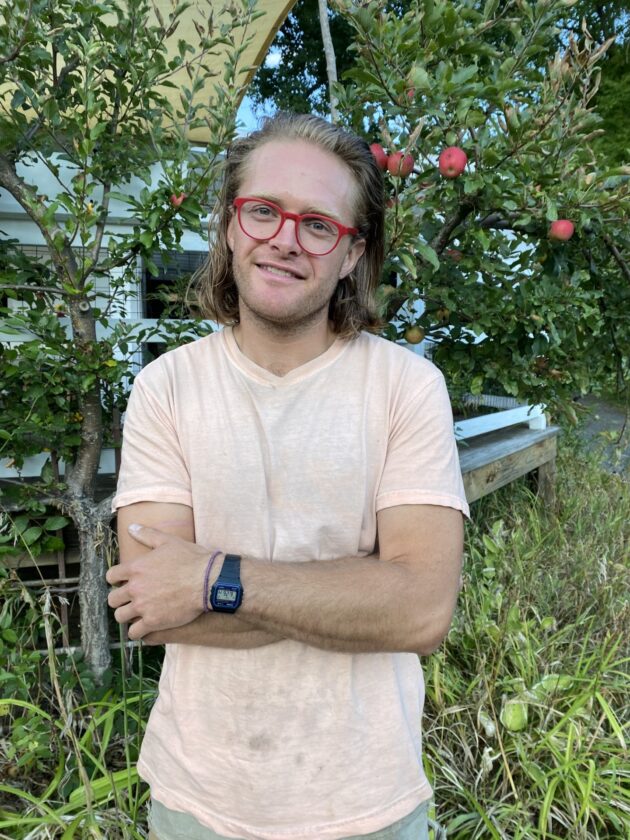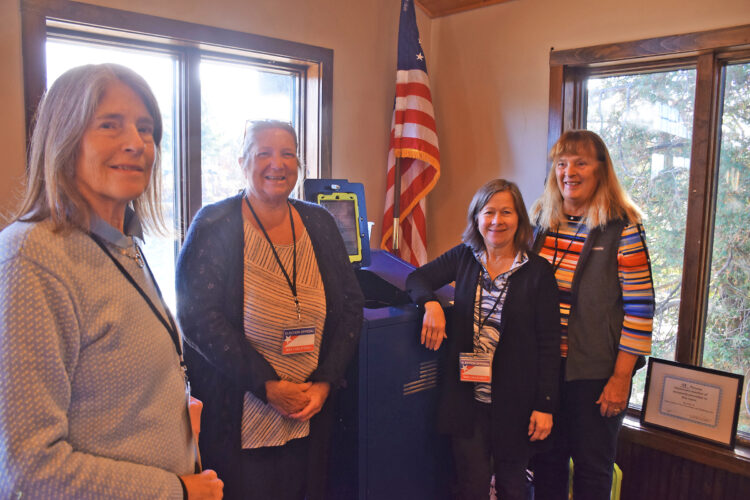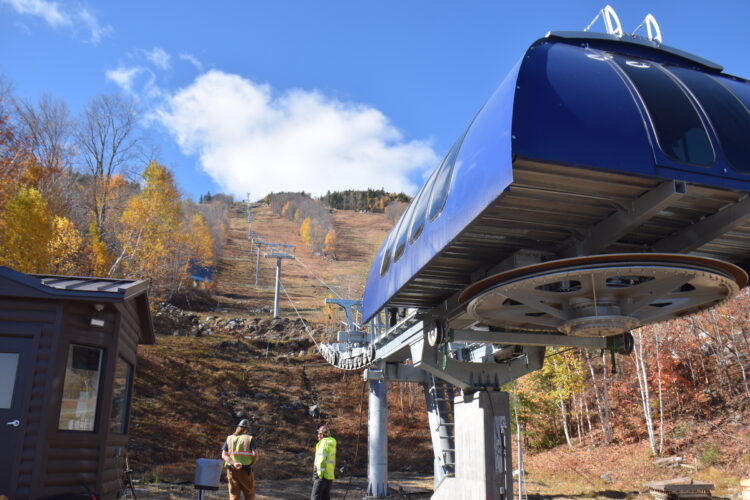PEOPLE AT WORK: Art and apples with Zach Clemens at Sandy’s Cidery

Shown here with the espaliered apple trees in front of Sandy’s Cidery, cider-maker Zach Clemens allows himself a brief post-Labor Day break. He will be curating The Emerging Artists Exhibition at Keene Arts the weekend of Sept. 12-14. (Provided photo — Martha Allen)
UPPER JAY — September. The days are shorter, the nights are colder and school has started. For weeks now the goldenrod has taken over fields and roadsides, blooming profusely. The season has turned, and perhaps no one is more aware of the change than Zach Clemens, of Sandy’s Cidery, located in the former bakery building on Route 9N in Upper Jay. The name refers to the nearby East Branch of the Ausable River; sable is French for sand.
Originally from Old Forge, Clemens worked as a chef in Brooklyn, New York. His summer dinner season at the cidery has just ended. Dinners, cooked by Clemens and served by friends, were entirely sourced from local farms. He scheduled the dinners on week days in order to allow himself time to hold two farmers markets, one on Saturdays in Saranac Lake and the other on Sundays in Keene.
For a dinner, Clemens would roast from 16 to 26 chickens over apple wood. Things have quieted down now, although he will continue to sell cider at the farmers markets until Oct. 12, when the markets close.
His cider can also be purchased at the Cidery and at East Branch Organics’ Wine and Spirits Shop in Keene.
Summer, Clemens said, is for executing, fall for harvesting and foraging and winter for his art projects. He is a painter, and he works in other media as well.
Clemens makes sparkling cider from wild apples and apples from abandoned orchards, wild and cultivated grapes, honey, edible wildflowers and other natural ingredients, some foraged and all sourced from the North Country. Some of that prolific goldenrod may be an ingredient in the glass you’re sampling. His cider is fermented with the natural wild yeast that is living on the apple skins when they are harvested. The end product is a drink no doubt closer to that enjoyed by the early colonists than the cider you’ll find in the supermarket, or even at the local cider mill.
Most of the “hard cider” mass produced commercially or made by hobbyists at home is produced American brewery style, Clemens explained. This method entails a rapid fermentation with juice, commercial yeast and refined sugar. The object of making cider brewery style, he said, is to produce alcohol.
Clemens makes both cider and wine using natural wine-making methodology instead of brewery methodology. Honey is used instead of sugar, which is a highly refined processed food. His attitude is one of guiding, or shepherding, as he puts it, rather than strict control of every step of the process.
Every batch of wine or cider will be different, depending on the fruit used. An apple with a flavor profile that combines sweetness with a tannic bitterness makes a good cider apple, Clemens said. The way the the cider is aged and the complete natural environment in which it is produced, including soil and climate, will all influence the cider’s flavor. The weather is a big factor.
What will this year’s harvest become?
“I let it unfold slowly and naturally,” he said. “I’m shepherding cider, not just making alcohol. I’m letting the landscape dictate what it becomes.”
Natural cider will be different year to year, lacking the consistency of a mass produced brand.
This year he has been taking care of a vineyard whose owner has retired from winemaking. It is, he said, his first time farming fruit.
“I’m letting nature do its thing, but I need to intervene a little to get a crop,” he said.
New York has been an apple state since the 18th century. The eastern states are well-suited to growing apples, but this didn’t happen entirely by accident.
When the first settlers came to America from England, they brought apple tree saplings with them, but as a rule English apples did not flourish. New England’s late frosts were apt to freeze and kill the budding blossoms, and so hardy American strains were developed. At one time thousands of apple varieties flourished in the United States, many of which have since been lost.
In recent years, Clemens said, the Hudson Valley Apple Project has inspired a change back to more natural cider making.
The Project’s test orchard in the historic farming community of Ancram, New York, features 160 varieties of heirloom and modern-day apples, including many varieties ideal for cider production.
This week, Clemens will be curating the third annual Emerging Artists Exhibit with East Branch Friends of the Arts at Keene Arts. The opening will be held Friday, Sept. 12, 5 to 8 p.m. For the remainder of the exhibit, the gallery will be open Saturday and Sunday, Sept. 13 and 14 and Friday to Sunday, Sept. 19 to 21, from noon until 5 p.m. Look for the former Methodist Church along the main road in Keene.
For the opening, “I’ll be shuffling fruit, grapes and cider — and an art installation,” he said.
There are similarities, according to Clemens, between art and cider making.
“Do what inspires you,” he said, and yeast, fruit and artists can all find expression.
His cider is aged in huge wooden bourbon casks before bottling. Cider he made in 2024 and bottled in 2025 will be finished and ready to sell in 2026, although, Clemens said, he sometimes wants to let it age a little longer and see what happens.
“I don’t know what’s in the barrels,” he said. “It’s exciting. A surprise … I think I’m getting better at it.”
They are what they are, he allowed.
“Maybe it’s predetermined … but it’s a mystery to me,” he said. “There’s magic in transformation.”



